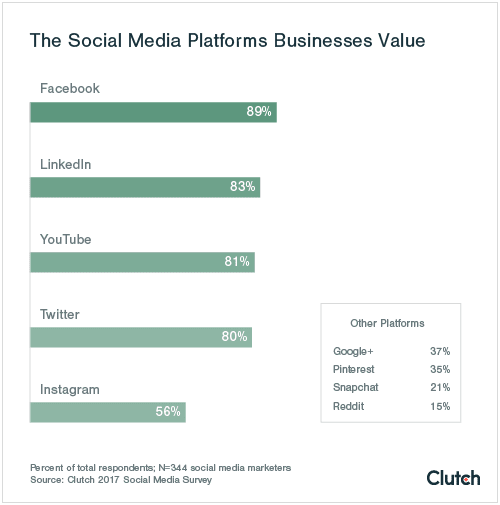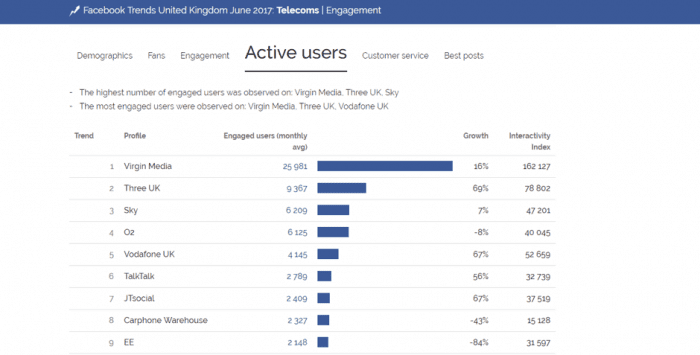6 key metrics to measure your social media impact and social media ROI
Social media is one of those tricky topics that marketing departments know is effective for business growth, but getting this across to other departments – and specifically the C-Suite – can be difficult. Measuring vanity metrics and talking about “social shares” is not something the senior team has any interest in; you have to show the business impact and value your social activity is having.
52% surveyed in the recent Smart Insights and Clutch Social Media report confirmed that social media has positively influenced their revenue and sales with Facebook and Linkedin providing the highest value for businesses.

But how to do you measure and prove this? Below we’re looking more closely at the metrics to focus on and how they can be demonstrated to the board as positively impacting business growth and sales.
Download FREE Resource – 10 common social media marketing mistakes guide
Our actionable guide to avoiding common social media marketing mistakes to help you avoid the pitfalls that limit engagement with your target audience.
Access the
Traffic
Utilising tools like Google Analytic make it easy to see how social is impacting on your overall traffic. Finding the actual value is about looking at the share of traffic driven and what actions those clickthroughs generated.
Track more than just the amount of traffic driven and actually look at the share driven by social. If social drives 25% of your traffic, this sounds much more effective than saying X number of visitors came from social – it provides context and value beyond an arbitrary number. Analysing the social media segment within Google Analytics will give you concrete figures to work with and present effectively as evidence of the impact of social media on your traffic.
Clickthrough Rate
Just tracking clicks is not enough and you need to focus in on more specific metrics related to your purposefully designed landing pages or gated content. Track the conversion ratio for clickthroughs on gated content which requires sign-ups or downloads.
Clickthroughs are an important metric but it is also recommended to look closely at clickthroughs in relation to bounce rate. Bounce rate is a clear sign of how effective your website/landing page or specifically designed content is. If someone clicks on your social link and then immediately clicks off, the “clickthrough” itself is irrelevant which is why the bounce rate matters – if they bounced off immediately, then your content on that particular website page didn’t deliver on the promise of the headline or CTA that caused the individual to clickthrough in the first place.
What content works?
By properly monitoring the bounce rate as well as clickthroughs you will soon get a picture of the kind of content that works for your business. All content will have some impact, but it’s how it can be measured that matters in this content. Vanity metrics such as likes and retweets have a more intangible impact, they indicate the performance of your campaign but do not demonstrate any direct business value. Website traffic, high engagement, and downloads of gated content show a more tangible impact.
Engagement
Meaningful engagement that leads to more brand awareness, interest or even sales is a truly powerful measure of impact of social activity. Volumes of Likes simply aren’t the focus here as they don’t indicate any level of commitment or meaning which you can quantify.
Real effort needs to be made to engage with your audience, as well as relevant industry influencers, and lazy attempts at engagement are easily spotted. Your audience are not to be underestimated and they’ll see the difference between a truly engaged brand and one which simply fires out the “Thanks for the RT” style tweets.
Working closely with industry influencers can really help your brand gain attention but you have to be mindful of who you approach and ensure you’re partnering with the kind of influencer who suits your brand and will amplify your message to the right audience.
Competitor Benchmarking
How are others in your sector performing? While competitor analysis is common, not many businesses are properly tracking and benchmarking their competitors’ progress. Looking at the performance across your sectors allows you to position yourself among your competitors and work to move your way to the top.
Using Facebook data from the telecoms sector as an example, research shows that the biggest Fan Pages aren’t necessarily those with the biggest growth. However, a close correlation was found between the number of engaged users and the highest levels of engagement, with the top two brands remaining the same for both higher number of engaged users and most engaged users.
Often having a lot of followers isn’t indicative of quality in engagement, but in the case of Virgin Media and Three UK this certainly isn’t the case.

Customer Service
Social media has made customer service in real time a genuine expectation of many customers. It can seem like a lot to ask, but with brands now offering set customer service hours on social or at least being available to answer questions and handle queries, it is something no business can ignore. Response times to queries and complaints need to be quicker, and response rates too have to be as high as possible.
After all, social media is so transparent, that all customers and prospects in your target audience can see how you interact online, so your brand’s reputation is always under scrutiny.
A brand’s behaviour in response to customers on social media says a lot about their overall approach to business and it can – and will – affect their brand reputation. What’s more, analyzing customer reactions to your responses can be an effective method for sentiment tracking for overall brand reputation.
Presenting your Social Media Value and ROI
Measuring social impact in a tangible way is essential for proving the ROI to your company’s C-Suite. They don’t want to know how many people a post has (potentially) reached, nor how many people follow you. They want to know what your social activities are contributing to the growth of the business.
Keeping the above points in mind and continually spending time on your social media analyses to pull out the important elements will soon show the return your investment in social media is delivering.
Thanks to Dan Purvis for sharing their advice and opinion in this post. Dan is Founder and Director at
Comms Axis, a full-service marketing agency specializing in content marketing, social media, and digital marketing for businesses of all sizes. Previously ranked by Brand Republic as one of the Top 50 UK Marketing and Social Media influencers, Dan Purvis is passionate about the philosophy behind Comms Axis: they bring content, marketing and sales together to connect businesses with their audiences. Dan is also proud to be a Media Champion for the Alzheimer’s Society and has raised nearly £10,000 for the charity since his father passed away in October 2016. You can follow him on
Twitter or connect on
LinkedIn.








